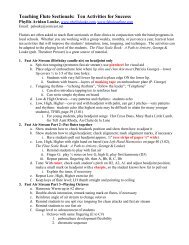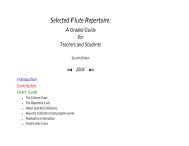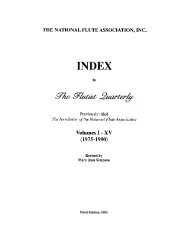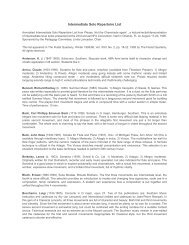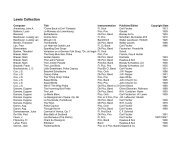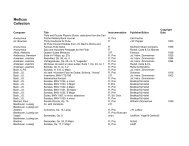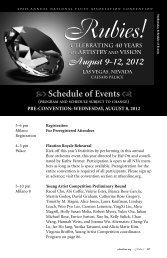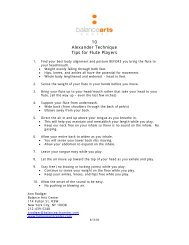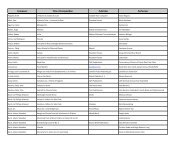Canadian Music for Flute and Piano Dr. Jennifer Brimson Cooper ...
Canadian Music for Flute and Piano Dr. Jennifer Brimson Cooper ...
Canadian Music for Flute and Piano Dr. Jennifer Brimson Cooper ...
You also want an ePaper? Increase the reach of your titles
YUMPU automatically turns print PDFs into web optimized ePapers that Google loves.
Sonata <strong>for</strong> <strong>Flute</strong> <strong>and</strong> <strong>Piano</strong> Srul Irving Glick (1934-2002)<br />
Ontario region composer, Srul Irving Glick (1934-2002) primarily studied composition with Ontarian<br />
composer, John Weinzweig, but was also exposed to the works of Darius Milhaud <strong>and</strong> Max Deutsch during brief<br />
periods of study. Glick’s works are best known <strong>for</strong> their lyrical melodic writing, tonal thematic language <strong>and</strong><br />
range of tone color. His works have been heavily influenced by immigration, demonstrating the use of British<br />
folk-like <strong>and</strong> jig melodies <strong>and</strong> a lyrical ballad style of writing. Many of his works also bear a strong association<br />
with nature, <strong>and</strong> he is known <strong>for</strong> his inclusion of Jewish melodies within his compositions. These are all apparent<br />
in his Sonata <strong>for</strong> <strong>Flute</strong> <strong>and</strong> <strong>Piano</strong> (1981). Within the work Glick exploits lyricism <strong>and</strong> chromatic harmony<br />
illustrative of a Neo-Romantic style yet creatively employs it within a Neo-Classical framework. This infusion of<br />
Neo-Romantic <strong>and</strong> Neo-Classical contexts in Glick’s Sonata <strong>for</strong> <strong>Flute</strong> <strong>and</strong> <strong>Piano</strong>, echoes that of Baker’s Sonata<br />
<strong>for</strong> <strong>Flute</strong> <strong>and</strong> <strong>Piano</strong>, op.2.<br />
Aria, op. 27 Jacques Hétu (1938-2010)<br />
Jacques Hétu is one of Canada’s most prolific composers. Based in the Quebec region, he wrote in a<br />
variety of genres including solo, chamber <strong>and</strong> orchestral repertoire. His music has been directly influenced by the<br />
French style; much of his flute repertoire echoes the music of Olivier Messiaen, <strong>and</strong> Henri Dutilleux having been<br />
exposed to their French compositional stylistic guises during his studies with them in France in the early 1960’s.<br />
Hétu’s approach to writing <strong>for</strong> flute <strong>and</strong> piano includes a variety in articulation, creative use of range <strong>and</strong> dynamic<br />
contrasts, <strong>and</strong> an endless range of tone color <strong>and</strong> expression. His Aria, opus 27, is best described within a Neo-<br />
Romantic context in its tonal ambiguity, rich chromatic dissonance, linear musical motives with large leaps, <strong>and</strong><br />
intimate interaction between the solo flute <strong>and</strong> piano lines.<br />
Sonata <strong>for</strong> <strong>Flute</strong> <strong>and</strong> <strong>Piano</strong>, op. 2 Michael Conway Baker (b. 1937)<br />
Michael Conway Baker (b. 1937) is a <strong>Canadian</strong> composer of American birth based in Western Canada.<br />
His music is best characterized in terms of jazz <strong>and</strong> popular style melodies representative of the American West<br />
Coast. Western <strong>Canadian</strong> region stylistic traits found in his Sonata <strong>for</strong> <strong>Flute</strong> <strong>and</strong> <strong>Piano</strong> include idiomatic<br />
instances of jazz <strong>and</strong> popular style lyrical melodic lines; other regional stylistic traits demonstrate evidence of folk<br />
song influence. His Sonata <strong>for</strong> <strong>Flute</strong> <strong>and</strong> <strong>Piano</strong> demonstrates basic theme development with use of folk <strong>and</strong><br />
ballad-style melodic writing. Stylistic guises of both Neo-Classical <strong>and</strong> Neo-Romantic movements are evident in<br />
this work. Baker further exploits the Neo-Classical idiom in his Sonata <strong>for</strong> <strong>Flute</strong> <strong>and</strong> <strong>Piano</strong> in his <strong>for</strong>mal plan -<br />
the work is divided into the st<strong>and</strong>ard three-movement Classical framework of fast-slow-fast.



